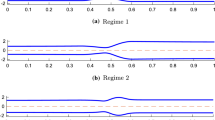Abstract
A fluid mechanical description of peristaltic esophageal transport is presented in pedagogical form, without equations and with minimal technical jargon, using simple theoretical models of peristaltic pumping. In the most basic model, a viscous fluid is transported along a tube of circular cross-section by periodic sinusoidal contractions of the tube wall. From this model the primary mechanisms of fluid transport are discerned, and an analysis is made of the proximal leakage of bolus fluid that results from incomplete luminal contraction. A modification of the theoretical model is described next, in which a fluid layer with viscosity different than the bolus fluid is placed adjacent to the tube wall to simulate the effect of a mucous coating in esophageal transport. With this model it is discovered that, when leakage can occur, a coating of low viscosity increases the amount of leakage and reduces net transport. Finally, the theory is applied to peristaltic wave characteristics that are more representative of esophageal bolus transport; and intrabolus pressures, computed using radiographic data of bolus shapes as input, are compared with manometric measurement.
Similar content being viewed by others
References
Brasseur, J.G., S. Corrsin, and N.Q. Lu. 1987. The influence of a peripheral layer of different viscosity on peristaltic pumping with Newtonian fluids.J. Fluid Mech. 174:495–519.
Christensen, J., E.O. Macagno, and J.G. Melville. 1978. Motility and flow in the small intestine.A.S.C.E. J. Engng. Mechs. Div. 104:11–29.
Coster, S.T., and W.H. Schwarz. 1987. Rheology and the swallow-safe bolus.Dysphagia 1:113–118.
Dodds, W.J., P.J. Kahrilas, and J. Dent. 1987. Considerations about pharyngeal manometry.Dysphagia 1:209–214.
Dodds, W.J. 1983. Radiology of the esophagus. In Margulis, A.R., Burhenne, H.J. (eds):Alimentary Tract Radiology, 3rd ed., vol 1, pp 529–603.
Donner, M.W. 1986. The evaluation of dysphagia by radiography and other methods of imaging (editorial).Dysphagia 1:49–50.
Jaffrin, M.Y., and A.H. Shapiro. 1970. Peristaltic pumping.Ann. Rev. Fluid. Mech. 3:13–36.
Lykoudis, P.S., and R. Roos. 1970. The fluid mechanics of the ureter from a lubrication point of view.J. Fluid Mech. 43:661–670
Orlowski, J., Dodds, W.J., Lineham, J.H., Dent, J., Hogan, W.J., and Arndorfer, R.C. 1982. Requirements for accurate manometric recording of pharyngeal and esophageal peristaltic pressure waves.Invest. Rad. 17:567–572.
Shapiro, A.H., M.Y. Jaffrin, and S.L. Weinberg. 1969. Peristaltic pumping with long wavelengths at low Reynolds numbers.J. Fluid Mech. 37:799–825
Author information
Authors and Affiliations
Rights and permissions
About this article
Cite this article
Brasseur, J.G. A fluid mechanical perspective on esophageal bolus transport. Dysphagia 2, 32–39 (1987). https://doi.org/10.1007/BF02406976
Issue Date:
DOI: https://doi.org/10.1007/BF02406976




